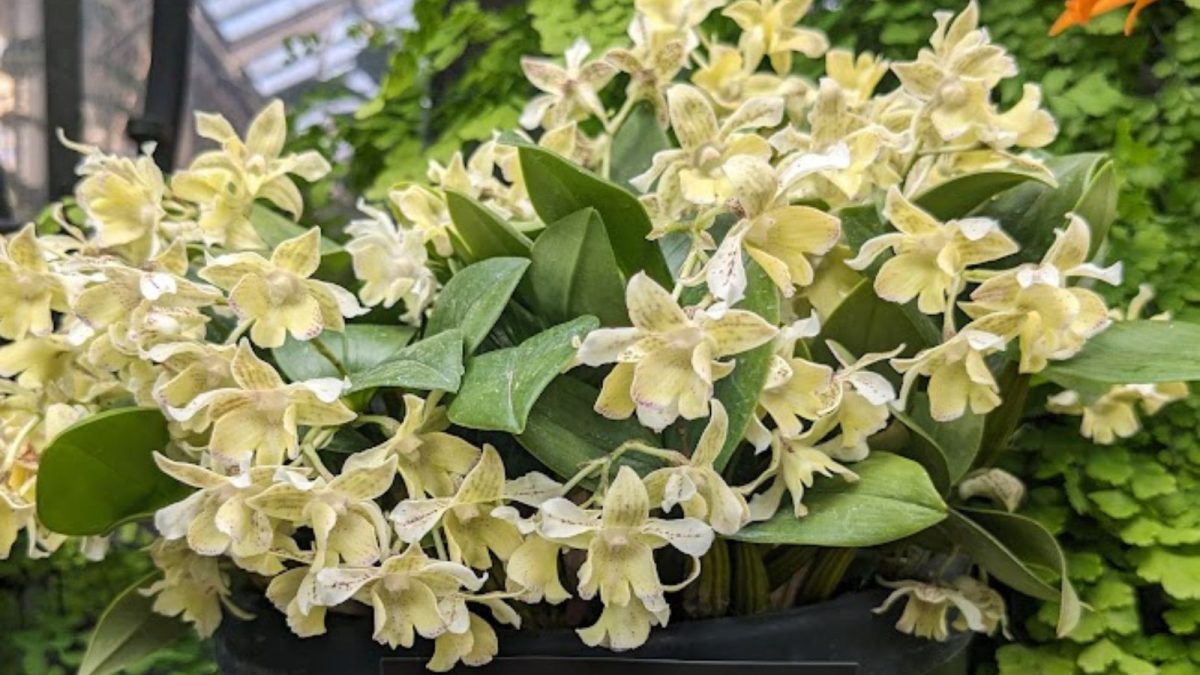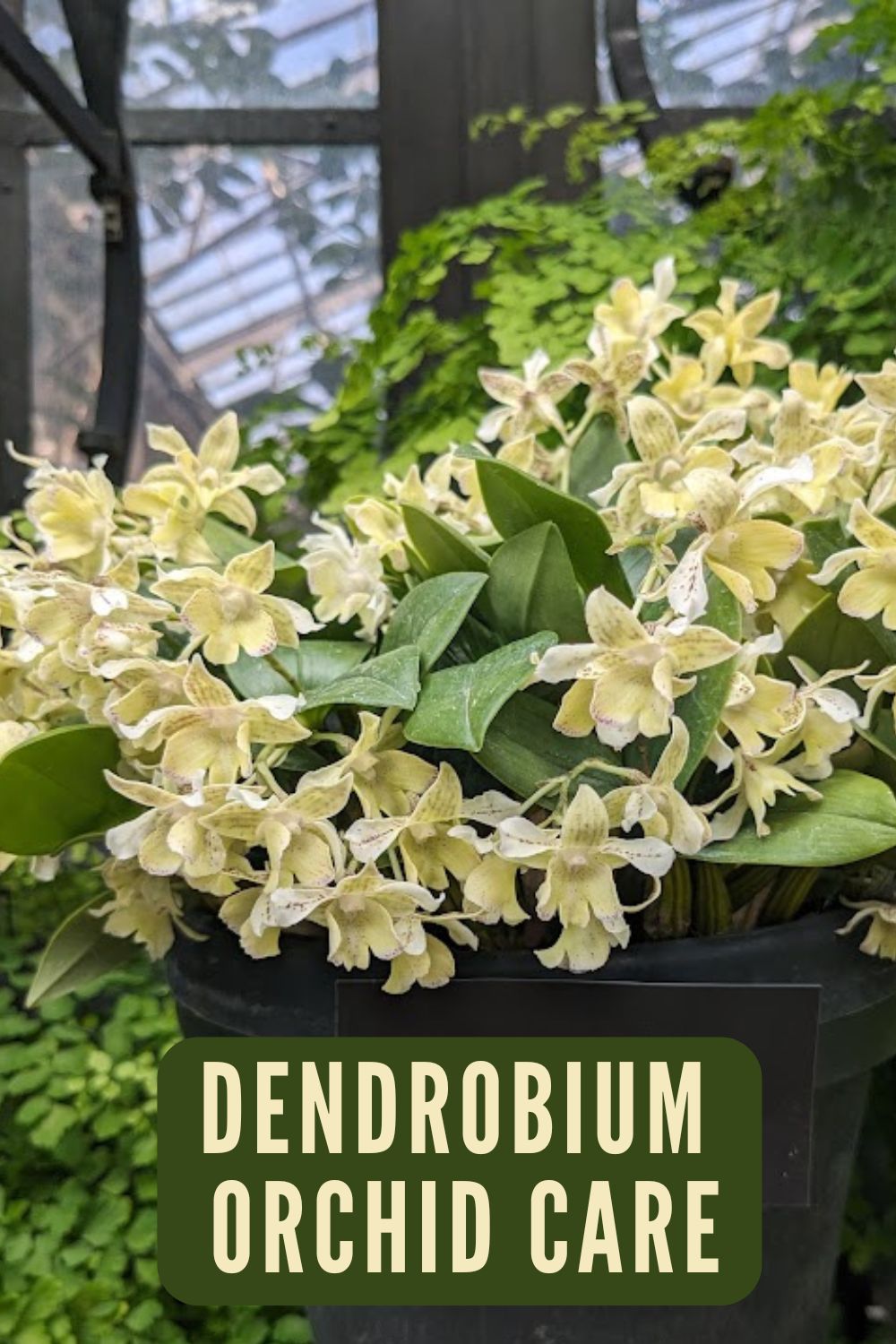Dendrobium orchids belong to one of the largest and most diverse genera in the entire orchid family, with over 1,500 recognized species. They are native to a vast range of habitats across Southeast Asia, Australia, and the Pacific Islands. As such, their care needs can vary, but most home-grown types share enough similarities to follow a general care routine.

The name “Dendrobium” comes from Greek and means “tree life,” referencing the fact that many of these orchids are epiphytes, growing on trees in their native environments. However, some also grow lithophytically (on rocks) or terrestrially.
Dendrobium Orchid Care
Growth Habits and Appearance
Dendrobiums have a sympodial growth pattern, meaning they grow sideways via pseudobulbs or canes that sprout from a horizontal rhizome. These canes store water and nutrients and may either be thin and upright or thick and arching. Some types shed their leaves seasonally (deciduous), while others retain them year-round (evergreen).
Most varieties bloom annually, though under optimal conditions, some can bloom more frequently. The blooms appear in clusters or along nodes of the canes, and in some types, flower spikes arise from the top of the canes like in phalaenopsis-type Dendrobiums.
Popular Dendrobium Types for Home Growers
- Dendrobium nobile: A deciduous type that produces clusters of fragrant blooms along leafless canes. Typically blooms in winter to early spring after a rest period.
- Dendrobium phalaenopsis (also called D. bigibbum): An evergreen type with tall, upright canes and large, long-lasting flowers that resemble moth orchids.
- Dendrobium kingianum: A compact, often fragrant variety from Australia that is very beginner-friendly and can thrive under a range of conditions.
Light Requirements
These orchids require bright, indirect light to thrive. A good rule of thumb: provide as much light as possible without burning the leaves. An east-facing window is ideal, but they can also do well in south or west-facing windows with sheer curtains or light shading.
- Too much light: Leaves may turn yellow or develop sunburn spots.
- Too little light: Leaves stay very dark green and flowering is limited or nonexistent.
Phalaenopsis-type Dendrobiums generally require slightly less light than Nobile types, but both still prefer bright conditions to initiate and maintain healthy flowering.
Temperature & Humidity
Most Dendrobiums do well in intermediate to warm household temperatures. Nobile types benefit from cooler fall temperatures to stimulate flower bud development.
- Daytime temperatures: 70–85°F (21–29°C)
- Nighttime temperatures: 60–65°F (15–18°C)
- Humidity: 50–70% is ideal, with good air movement to prevent fungal issues.
Watering Schedule
Dendrobiums should be watered thoroughly but allowed to dry slightly between waterings. Never let the plant sit in water. The correct watering frequency will depend on pot size, potting medium, light, and air movement.
- Growing season (spring/summer): Water regularly when the top of the medium dries out.
- Dormant season (fall/winter): Reduce watering—especially for deciduous types like D. nobile. Allow canes to rest and harden off before the next bloom cycle.
Fertilizing
Feed actively growing plants with a balanced orchid fertilizer diluted to 1/4 or 1/2 strength. Fertilize weekly during the growing season and reduce or stop during the rest period in fall and winter.
Use a “weakly, weekly” approach and flush the potting medium with plain water once a month to prevent salt buildup.
Potting and Medium
Dendrobiums grow well in a coarse, fast-draining orchid mix such as bark, charcoal, and perlite. Avoid fine or moisture-retentive media, as this can lead to root rot. Use a container that allows for good drainage.
- Repot every 2–3 years or when the potting medium breaks down.
- Repotting is best done in spring after blooming, just as new growth appears.
These orchids prefer to be slightly pot-bound, so don’t move them to larger pots unless necessary.
How to Encourage Blooming
Blooming is often triggered by a shift in environmental conditions, such as reduced watering, cooler nights, and increased light intensity in fall.
For D. nobile types, it’s important to allow a rest period with:
- Cooler night temperatures (around 55°F or 13°C)
- Reduced watering (just enough to keep canes from shriveling)
- No fertilizer
Once buds appear along the cane, gradually resume normal watering. Flowers typically last several weeks and can be delightfully fragrant.
Maintenance and Troubleshooting
- Support tall canes with stakes if they begin to lean.
- Remove spent flowers and allow canes to mature naturally.
- Don’t remove old canes unless they’re fully shriveled—some orchids bloom from older growth.
- Watch for pests like scale, spider mites, or mealybugs—wipe leaves regularly and treat infestations promptly.
Dendrobium orchids are incredibly rewarding plants with stunning blooms and a wide range of colors and forms. With proper light, watering, and seasonal care, they can thrive and rebloom for years. Whether you’re drawn to the elegant D. phalaenopsis types or the fragrant clusters of D. nobile, Dendrobiums can be a joyful addition to any orchid collection.

